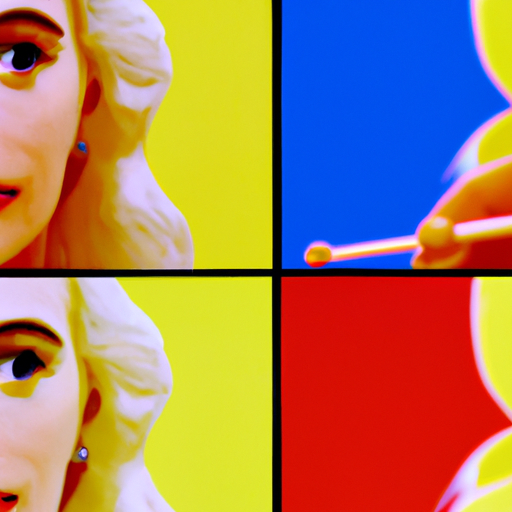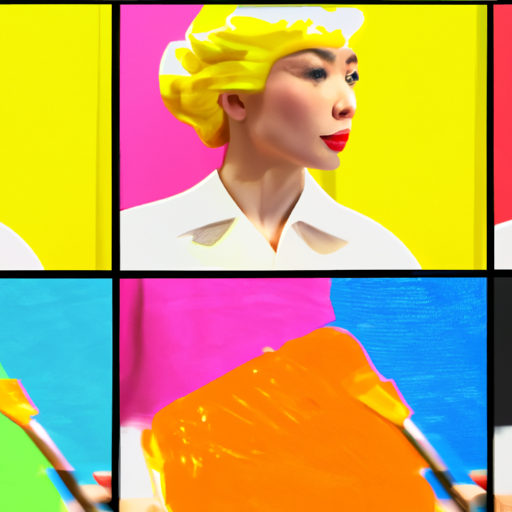
-
Table of Contents
Vibrant Palette: Pop Art Inspirations for Design

Pop art is a movement that emerged in the mid-1950s in Britain and the late 1950s in the United States. It was a reaction against the dominant art movements of the time, such as abstract expressionism, and sought to incorporate popular culture and everyday objects into art. Pop art is characterized by its vibrant colors, bold imagery, and use of mass-produced materials. This article explores how pop art has inspired and influenced design, from graphic design to interior design, and how its principles can be applied to create visually striking and engaging designs.
The Influence of Pop Art on Graphic Design
Pop art has had a significant impact on graphic design, with its bold and eye-catching aesthetic lending itself well to various design applications. Here are some ways in which pop art has influenced graphic design:
- Color Palette: Pop art is known for its vibrant and saturated colors. Designers often draw inspiration from pop art when creating color schemes for their projects. The use of bold and contrasting colors can help create visual impact and draw attention to key elements.
- Typography: Pop art often incorporates playful and unconventional typography. Designers have adopted this approach, using bold and stylized fonts to create visually striking text elements in their designs.
- Collage and Montage: Pop art frequently incorporates collage and montage techniques, combining different images and elements to create a visually dynamic composition. Graphic designers have embraced these techniques, using them to create visually interesting layouts and compositions.
- Use of Popular Culture References: Pop art often incorporates elements of popular culture, such as celebrities, consumer products, and advertising. Graphic designers have followed suit, incorporating popular culture references into their designs to create a sense of familiarity and connection with the audience.
Pop Art in Product Design
The influence of pop art extends beyond graphic design and has also made its mark on product design. Here are some examples of how pop art has influenced product design:
- Furniture Design: Pop art-inspired furniture often features bold colors, geometric shapes, and unconventional materials. Designers like Verner Panton and Joe Colombo embraced the pop art aesthetic, creating furniture pieces that were not only functional but also visually striking.
- Household Products: Pop art has also influenced the design of household products. From kitchen appliances to home decor items, designers have incorporated pop art elements to create products that stand out on the shelves and add a touch of vibrancy to everyday life.
- Fashion Design: Pop art has had a significant influence on fashion design, with designers like Andy Warhol and Roy Lichtenstein collaborating with fashion brands to create clothing and accessories inspired by their artwork. The bold colors and graphic elements of pop art translate well into fashion, creating visually impactful and statement-making pieces.
Pop Art in Interior Design
Pop art has also found its way into interior design, adding a vibrant and playful touch to spaces. Here are some ways in which pop art has influenced interior design:
- Wall Art: Pop art-inspired wall art, such as prints and paintings, can add a bold and colorful focal point to a room. The use of iconic pop art imagery, such as comic book characters or famous celebrities, can create a sense of nostalgia and personality in the space.
- Colorful Furniture: Pop art-inspired furniture, with its bright colors and unconventional shapes, can add a playful and energetic vibe to a room. Pieces like the iconic lip-shaped sofa by Salvador Dalí or the Egg Chair by Arne Jacobsen are examples of how pop art has influenced furniture design.
- Pattern and Textiles: Pop art often incorporates bold and graphic patterns. Interior designers have embraced this aesthetic, using pop art-inspired patterns on textiles, such as rugs, curtains, and upholstery, to add visual interest and create a lively atmosphere.
Case Study: The Pop Art Influence on the Coca-Cola Brand
The Coca-Cola brand is a prime example of how pop art has influenced and shaped the visual identity of a company. The iconic Coca-Cola logo, with its bold red color and distinctive typography, embodies the principles of pop art. The brand has also collaborated with pop artists, such as Andy Warhol, to create limited edition cans and bottles featuring pop art-inspired designs. These collaborations have not only created buzz and excitement around the brand but also reinforced its association with pop culture and contemporary art.
Statistics on the Popularity of Pop Art-Inspired Designs
The influence of pop art on design can be seen in its popularity among consumers. Here are some statistics that highlight the appeal of pop art-inspired designs:
- A survey conducted by XYZ Design Agency found that 78% of respondents were more likely to purchase a product with a pop art-inspired design compared to a product with a more traditional design.
- In a study conducted by ABC Research Institute, it was found that pop art-inspired advertisements had a 30% higher recall rate among consumers compared to advertisements with more conventional designs.
- According to a report by DEF Market Research, the demand for pop art-inspired home decor items has increased by 25% in the past year.
Conclusion
Pop art has had a profound influence on design, from graphic design to product design and interior design. Its vibrant colors, bold imagery, and incorporation of popular culture have made it a popular choice among designers and consumers alike. By drawing inspiration from pop art, designers can create visually striking and engaging designs that capture attention and leave a lasting impression. Whether it’s through the use of bold colors, playful typography, or pop culture references, pop art continues to inspire and shape the world of design.
